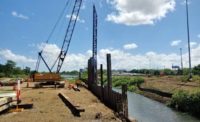More than $3 billion in flood risk reduction and repair projects can move forward in Houston following a vote held on Hurricane Harvey's anniversary that authorized a $2.5-billion bond program.
Those bonds will be used to fund 237 projects, including three large detention basins across the county.
"We've already received approval from court to start negotiating 14 contracts with engineering firms that are all bond-related projects. So, step one is to get these projects initiated and get the contracts needed in place so that we can start the design for these projects," says Matt Zeve, director of operations for the Harris County Flood District, noting that all of the projects have to be approved by the Harris County Commissioners Court.
Bond funding will available in about 60 days, according to the Harris County Budget Management Department. "So best case scenario, we'll start seeing funding in November," Zeve says. Projects under the direct scope of the bond program are "well over a year away" from being let for bid.
The projects and land acquisitions, which will occur over the next 10 to 15 years, include the three detention basins, repairs to Buffalo Bayou and acquisition of thousands of pieces of property. Many of the projects will also tap into separate federal funding, bringing the total of the projects to more than $3 billion.
"One of the largest contracts will be for de-silting projects for 30 different channels on the west side of Harris county … because of the sheer volume of work involved," Zeve says. The district will also update preliminary engineering reports and complete final design for drainage improvements to neighborhoods in central Houston.
The bond projects were selected after a series of public meetings held across Harris County this summer and were based on criteria such as readiness for preliminary engineering, design or construction, and clearly defined drainage issues and flood-risk-reduction benefits.
"High on the priority list for Bond Program projects are construction-ready projects with federal funding partners (such as the U.S. Army Corps of Engineers and the Federal Emergency Management Agency) that give our county 'the most bang for its flood control buck,'" according to the flood control district's website.
But the programs will only make a dent in the area's flooding problems, Jim Blackburn and Philip Bedient of Rice University's Severe Storm Prediction, Education and Evacuation Center concluded in a report they released on Houston a year after Harvey. Much of the problem is that the floodplain isn't well defined. While there are efforts to update what constitutes the 100-year and 500-year floodplain, federal projects being designed now are based on the old floodplain maps, they said.
"As a result, there will still be homes near creeks and bayous that will remain at risk of flooding even with a lot of money being spent on federal and local improvement projects. This is unfortunately an unavoidable fact," according to the report. The report also says there are real financial limits to what can be done.
Houston Mayor Sylvester Turner said Aug. 25 that the city has received $2.5 billion in long-term recovery money from the Federal Emergency Management Agency and another $4.29 billion in FEMA funds as direct aid to Houston citizens, but he is pushing for more.
Turner called upon Texas Gov. Greg Abbott to tap the state's $12-billion rainy-day fund to help projects in Houston get started while the city awaits federal funding.
On Aug. 29, the city was selected as a 100 Resilient Cities member. Shell is sponsoring the effort, with $1.8 million in funding. As a part of the effort, Houston will hire a chief resilience officer and develop a comprehensive resilience strategy. Stephen Costello, who now has the title of chief resilience officer, will become the city's full-time "flood czar," according to Turner.







Post a comment to this article
Report Abusive Comment